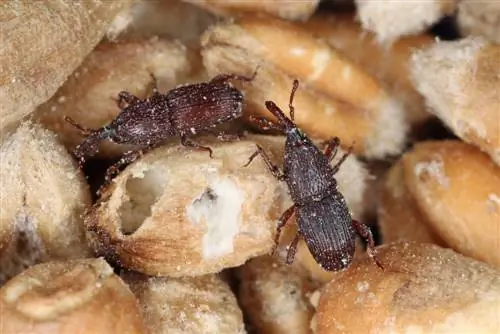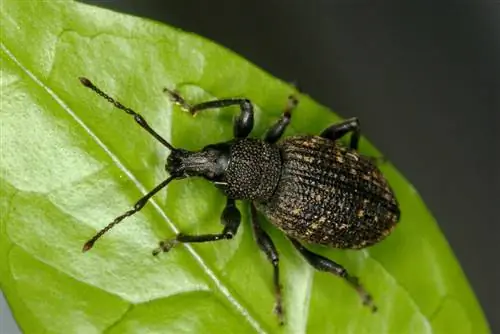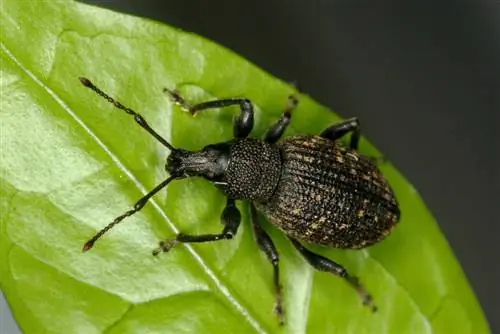- Author admin [email protected].
- Public 2023-12-16 16:46.
- Last modified 2025-06-01 06:02.
If black beetles appear in the house, solve the problem with a two-step plan. In Germany these are often pests that are after your belongings, spoil supplies or tamper with house plants. The specific type of pest determines the correct approach. You can find out how to correctly identify black beetles indoors and combat them biologically here.
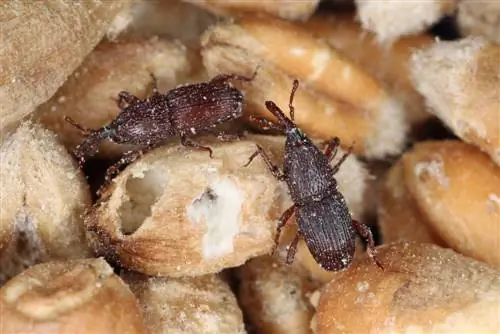
How to fight black beetles in the house?
To combat black beetles in the home, it is important to identify the species. Storage pests such as flour and grain beetles can be controlled with heat, cold, disinfection and disposal of infested food. Hot laundry, heat, cold and oxygen deprivation help with material pests such as fur beetles and house beetles. Rapeseed beetles as plant pests can be controlled with lemon scent, live fishing gear or self-made yellow traps.
- The 5 most common black beetles in the house are: flour beetles and grain beetles (storage pests), fur beetles and house beetles (material pests) and rapeseed beetles (plant pests).
- Product pests can be combated with heat (60°), cold (-18°), disinfection and disposal of infected food.
- Organic remedies against material pests include hot laundry, heat (80°-100°), cold (-18°) and oxygen deprivation.
- Rapeseed beetles as plant pests in the house can be controlled with lemon scent, live fishing gear or self-made yellow traps.
Identify black beetles in the house
A two-step plan has proven to work well in practice when small black beetles cause headaches in the house. As a first step, a well-founded identification of the species is recommended. Thanks to this insight, you know exactly what to do as an effective countermeasure. Black beetles in the house can be storage, material or plant pests.
| Black Beetles | Flour Beetle | grain beetle | Black Fur Beetle | Hausbock | Rape beetle |
|---|---|---|---|---|---|
| Size | 10-18mm | 2-4 mm | 3, 5-6 mm | 8-26mm | 1, 5-2mm |
| Body shape | slender, elongated | elongated, stretched | elongated, pencil-shaped | slim, elongated | round-oval |
| Special feature | Elytras with longitudinal grooves | long trunk | thick hairy | gray haired | metallic iridescent |
| Botanical name | Tenebrio molitor | Sitophilus granarius | Attagenus pellio | Hylotrupes bajulus | Brassicogethes aeneus |
| Beetle Family | Black Beetle | Weevils | Speck Beetle | longhorn beetle | Glitter Beetle |
| Status in the house | storage pest | storage pest | Material pest | Material pest | Plant pest |
It's not so easy to identify small black beetles that fly around the house or only venture out of cover at night. For more in-depth information, please take a look at the following short species portraits with further clues for clear identification.
Flour beetle (Tenebrio molitor)
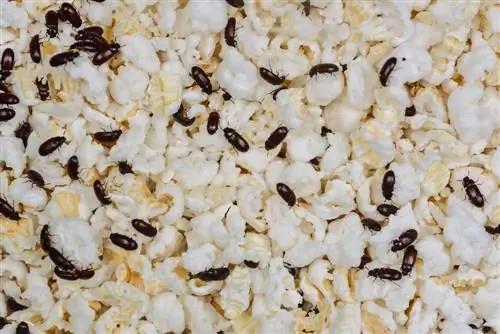
The flour beetle is found mainly but not only in flour
Tiny black flour beetles are after your supplies. Flour, grain and baked goods are very popular with the elongated black beetles. If you catch one of the nocturnal pests in the act, you will see numerous longitudinal grooves on the curved elytra, while the frightened beetle runs away on its red-brown legs.
Grain beetle (Sitophilus granarius)
A dark brown to black grain beetle is still tiny even in its prime. You need an eagle's eye or a magnifying glass so that you can locate the characteristic head extension of the small weevil. Deep grooves on the dark cover wings and point-like depressions on the pronotum serve as additional identifying features. The following video gives an exciting insight into the life of the most feared pest in Germany:

Black fur beetle (Attagenus pellio)
The black fur beetle is a widespread material pest. The golden-yellow, 15 mm long larvae primarily target woolly materials, such as fur, carpets or winter sweaters. Dried meat, salami, dried ham, sausage, and dry dog and cat food are also affected. The black, elongated-oval beetle can be recognized by its pronotum with 3 light spots. The densely hairy wing coverts are decorated with two light spots. The first seven segments of the antennal segments are reddish in color.
House buck (Hylotrupes bajulus)
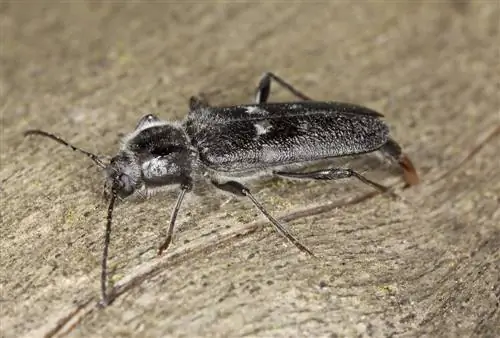
The house buck causes great damage to wood
If you see small, black, elongated, flat beetles in the house, you should not take this encounter lightly. The color and body shape already indicate that the pet goat has arrived in your home. Further clues to the identity of the dreaded wood pest include white hair patches in the front third of the dark elytra and two small bulges in the pronotum.
Rape beetle (Brassicogethes aeneus)
Rape beetles can be found in the house, especially when the rapeseed is blooming. Because the tiny, black beetles like to sit on yellow or white flowers, they quickly catch the eye. If you look closely, you can admire the shimmering metallic cover wings, which sometimes shimmer dark blue or dark green. The rather short antennae end in a club shape.
Excursus
Put nuisances gently outside the door
Sometimes little black beetles get lost in the house, fly around everywhere and get on your nerves. This includes the spherical, thick Asian lady beetle (Harmonia axyridis), which does not always boast red dots on its shiny black cover wings. Various tiny black ear beetles (Malachiidae) get into the apartment and can't find their way out. Insect lovers do not condemn the pests to death, but rather transport the uninvited guests back outside alive. It is often enough to open the windows and balcony doors for a while. Use the glass trick to gently place isolated beetles in front of the door. Simply put a glass over it, put paper or cardboard under it, carry it outside and release the prisoner into freedom.
Black beetles indoors - combat pests
It's worth keeping a cool head and first identifying the type of beetle that's boldly spreading around the house. This directly results in exactly the right means and measures to combat it. This strategy is more effective, cheaper and ecologically more sensible than triggering a mindless overkill of measures or swinging the chemical club. The following table gives an overview of how you can biologically combat black beetle pests in the house:
| Fight biologically | Pest Pests | Material pests | Plant pests |
|---|---|---|---|
| Means/Method | destroy infected foods | washing | distribute |
| How to use? | throw in the organic bin | wash at 60° | Lemon Scents/Lemongrass |
| Means/Method | Heat (60° Celsius) | Heat (80° Celsius) | collect |
| How to use? | 30-45 minutes in the oven | 1 hour in the sauna | capture with Snapy |
| Means/Method | Cold (- 18° Celsius) | Cold (- 18° Celsius) | Build a yellow trap |
| How to use? | Freeze for 24 hours | 48-72 hour freezer | Water-dishwashing liquid mix |
| Means/Method | Cleaning/Disinfection | Withdraw oxygen | |
| How to use? | hot wipe with Sagrotan | pack airtight |
By combating the immediate infestation, the problem is only superficially solved. Then start looking for the cause of the disaster. Flour beetles and grain beetles use your grocery shopping as an entrance gate. Therefore, check in the store whether there are any pests hiding in the goods. Transfer food to tightly closed storage containers. Textiles from the second-hand shop often have material pests on board.
Tip
Most small black beetles are excellent at flying. With somnambulistic security, the insects find out where a window is tilted or a balcony door is open. How disappointing for the winged invaders when they collide with a tight insect net that prevents them from entering.
Fighting pests in supplies and materials - tips & tricks
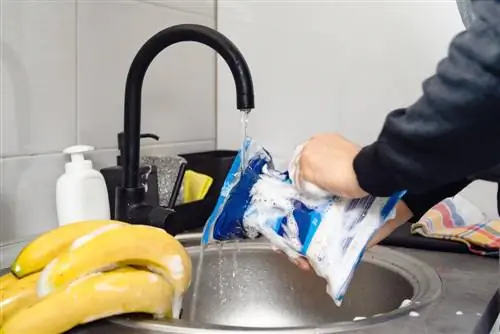
If pantry pests are suspected, the cupboard and packaged food should be thoroughly cleaned
In addition to the above table for biological control agents against stored product and material pests, we have put together practical tips and tricks for you:
- Always dispose of visibly contaminated food in organic waste
- Only if suspected, disinfect dry supplies in the oven at 60° Celsius on a baking tray or in a fireproof dish
- Alternatively, put suspect foods in the freezer for at least 1 day
- Suck out cupboards and drawers with infected supplies, wipe with hot water and disinfect with Sagrotan
- Wash beetle-infested textiles at least 60° Celsius (please follow washing instructions)
- Put carpets, textiles, leather and similar materials in the sauna for 60 minutes at at least 80° Celsius
- Freeze for 2 to 3 days (recommended for sensitive wool textiles)
- Pack contaminated items in airtight plastic bags for 2 to 3 weeks
The thermal control of fur beetles, woodworms and the like on large objects represents a particular challenge. If you have good contacts with the local master carpenter, you may be able to use the company drying chamber upon request. If a sauna is not available, expose the affected materials to the blazing summer sun under a foil hood. In cold winter regions with temperatures well below -10° Celsius, you can give material pests a real cold shock outside under a tent.
Fighting tiny rape beetles as plant pests
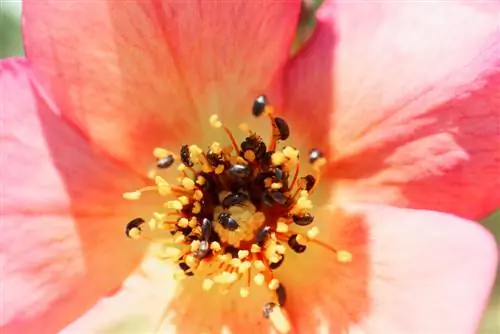
Rape beetles prefer wildflowers, but if necessary they will also settle for houseplants
Rape beetles and indoor gardeners will probably never become friends. The tiny creatures often sit as stowaways in wildflowers and forest herbs they have picked themselves. Cut off from their favorite food, rapeseed, the shiny black beetles in the house make do with potted plants on the windowsill. How to combat rape beetles as plant pests without poison:
- Dispel: set up lemongrass or aroma lamps with lemon scent in the house, lay out lemon slices
- Catch and release: use the glass trick or live capture device Snapy to capture individual beetles and release them outside
If rapeseed beetles cannot be driven away or caught in the house, the yellow trap comes into play. Fill a small yellow bowl with water and a little dishwashing liquid. Place the trap in locations in the house with an increased number of beetles. Their preference for the color yellow is the rape beetle's downfall.
Frequently asked questions
How can you prevent beetle infestation on supplies?
You can keep pantry pests away by storing food in sealed containers. Ideally, after opening the packaging, you should immediately pour dry foods into Tupperware containers, such as coffee, sugar, flour or cereal. Freezing is also an effective form of prevention. At the very least, it is advisable to keep supplies as cool as possible to keep flour beetles or grain beetles away.
Are black beetles in the house harmful to your he alth?
Foods infected with storage pests are no longer suitable for consumption. Flour beetles and their larvae can transmit parasites, such as dwarf tapeworms. If grain beetles misuse their supplies as a source of food and nursery, there is a risk of consequential damage from mites and mold. In contrast, fur beetles, house beetles and rape beetles are destructive beasts, but do not pose a he alth risk.
Tip
Numerous species of bugs can hardly be distinguished from a black beetle, but are completely harmless. A prime example is the black bullet bug (Coptosoma scutellatum). She loves it cozy and warm and likes to come into the house as a winter guest in autumn. Round and thick, 5 mm small, with 6 legs, pronotum and antennae, the bug looks very similar to a black beetle. You can read here why bedbugs deserve their bad reputation and why they should be distinguished from beetles.

